Friday, 17 May, 2019. 22:37
It’s late and we’ve had a very busy day, going to Belém and exploring the various attractions there, before having a wonderful dinner in Chiado. But now it’s late and I need to sleep, so I’ll write about it tomorrow.
Written next day
Let me tell you about the footpaths in Lisbon. They’re not concrete or asphalt or paving stones or anything sensible like that. They’re cobblestones. All of them. Even the footpaths way out in the suburbs. Every single one. And not good solid basalt or granite cobbles with sharp edges and a rough surface, but limestone. Soft limestone that wears away on the surfaces and edges leaving them all rounded and smooth. And slippery. And Lisbon is a city of hills. Try walking down a steep hill paved with rounded, slippery cobblestones. I can’t even imagine how nightmarish this city would be in the rain.
Another thing about Lisbon is that black seems to be the most popular car colour, by far, followed by dark grey. The streets are a sea of vehicles absorbing the hot Atlantic sun, punctuated only by the odd car in red or white. It seems an odd choice for a place that obviously gets a lot of hot weather
On Friday morning we tried to sleep in a little, but still got up close to 07:00. For breakfast today I tried the hot breakfast service, gathering a plate of onions, ham, tomatoes, cheese, and rocket and then handing it to a waiter and asking it to be incorporated into a plate of scrambled eggs. The eggs arrived just I finished my muesli, and were cooked very nicely. I ate them with a couple of the small bread rolls that have been delicious every morning.
M.’s toes have started to blister a bit from all the walking she’s been doing, so while she returned to the room, I dashed across the road to the supermarket to buy some band aids. It was cold this morning, but I figured I’d only be outside walking for a minute. However when I got there, the supermarket hadn’t opened yet, the sign at the door saying it opened at 08:00. It was five minutes to, so I waited for it to open, in the chilly morning air. Eventually it opened and I bought the band aids. After wrapping some around a couple of M.’s toes we prepared to leave for the day.
We walked over to Roma station to get a green line train without having to change twice, and rode it to the end of the line at Cais do Sodré. The train was packed, and at one station a couple of old ladies got on and I overheard one remarking to the other in Portuguese, with the word “sardinhos” clearly being said. Most of the passengers stayed on all the way to our stop, where everybody spilled out.
Heading upstairs to the heavy rail lines, we used our Viva Viagem cards to pass through the access gates, then tried to figure out what platform to go to. The final destinations of trains were displayed next to a rapidly scrolling list of stations. We both scanned the board, and M. spotted Belém listed on one, so we headed up to platform 2, where a train was sitting waiting. We didn’t know if this was the right train to get on, so M. asked a woman getting on if it went to Belém. The woman was confused for a while as M. repeated the destination, until she finally clicked and said, “Ah! Blem! Sim!” Pronouncing words in Portuguese is very tricky!
The train was nearly empty so we got good seats. It left after a few minutes and glided along the river westwards. Belém is pretty close and it was only three stops until we arrived there, taking a bit under ten minutes. We got out and climbed a rickety old narrow metal bridge to cross the tracks and the adjacent main road to get to the side we wanted to be on.
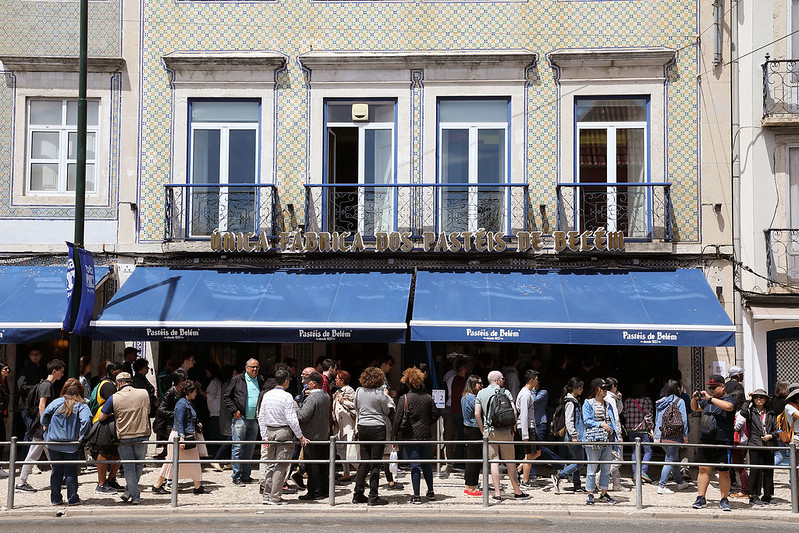 Pastéis de Belém, the original Portuguese tart shop |
Walking through a small park and then down a busy street took us to the Pastéis de Belém shop, founded in 1837 and home of the invention of the Portuguese custard tart: pastel de nata. Today it does a thriving business still selling the original recipe tarts, and tourists flock to it. We arrived about 09:15 and there was a queue of about 20 people to buy take away tarts. There was also another entrance with a sign promising table service, with 400 seats. M. fancied sitting down for a coffee, so we went in there, but inside it was confusing with people in front of us waiting around, and then people coming in behind us and apparently just ignoring the queue and heading deeper into the shop. There was no sign of people being seated at tables. So we decided to go out and join the take away queue, which at least was moving in an orderly fashion.
 Queuing at Pastéis de Belém |
Once inside again, we ordered a pack of six tarts, and a cappuccino for M. to drink standing at the counter. While waiting I opened the take away pack of tarts to get out one for each of us to eat, and a man behind the counter saw what we were doing and gave us a plate, and opened the box for us and set two tarts out with tongs. The cappuccino arrived, with a huge mound of whipped cream on top, which M. scooped onto the plate. The tarts were hot and delicious, the pastry very crisp and flaky. The man also gave us shakers of sugar and cinnamon to add to the tarts. I added cinnamon to mine, which made it even more delicious. Really, this was the way to do it, eating and drinking standing up at the counter, rather than wait for slow service at a table and pay extra for the privilege.
 Our tarts at Pastéis de Belém |
Not far from the pasteleria was the Monastery dos Jerónimos, the next biggest attraction in Belém, and a World Heritage Site. The white facade gleamed in the sunlight, looking impressive with its spires and detailed carved stonework. A queue was forming with ten minutes or so until opening time at 10:00, and more tourists were milling about, including large tour groups, looking ready to add to the end of the queue with alarming rapidity. So we joined the queue, and then discovered that it seemed to be two separate queues, one for the monastery church, for which a sign advertised free entry, and a second queue to enter the monastery proper, for which you needed to possess a ticket. After walking to the front of the queues to investigate the rather uninformative signage, I realised that they weren’t selling tickets here, but rather at another door some 100 metres further down the exterior of the building.
 Monastery dos Jerónimos, showing entrance queue, photo taken from near the ticket office |
I left M. to mind our place in the rapidly growing queue while I dashed down to the ticket office to buy us tickets. There were not many people here, so I surmised that most of the people must have bought their tickets online. Although the queue at the ticket office was only about 20 or 30 people in front of me, it moved extremely slowly. When I got inside I realised why: there were no humans selling tickets, it was all done by automated machines, and several of the elderly people lined up to buy tickets were taking forever to work out how to do so. Eventually I reached a machine and purchased two tickets for 10€ each. It was well past 10:00 by the time I returned to find M. still waiting in the apparently unmoved queue.
 The entrance to the church of Monastery dos Jerónimos |
It looked like we were in the queue for the church, but with now several hundred people behind us in each queue, we decided to look at the church first and then go for the monastery afterwards with our newly purchased tickets. A minute or two later, a man came out from the front of the church queue, looked at the sign with the arrow and “free entry” pointing towards the door, made a “tut tut” noise and shaking of his head, grabbed the sign, turned it around so the arrow pointed down the exterior of the building to the next door along, and started waving everyone to go over there! The horde surged in that direction, but a few people, including us, used the opportunity afforded by the chaos to move laterally into the monastery queue, thereby keeping our place relatively near the front and switching to the more desirable queue.
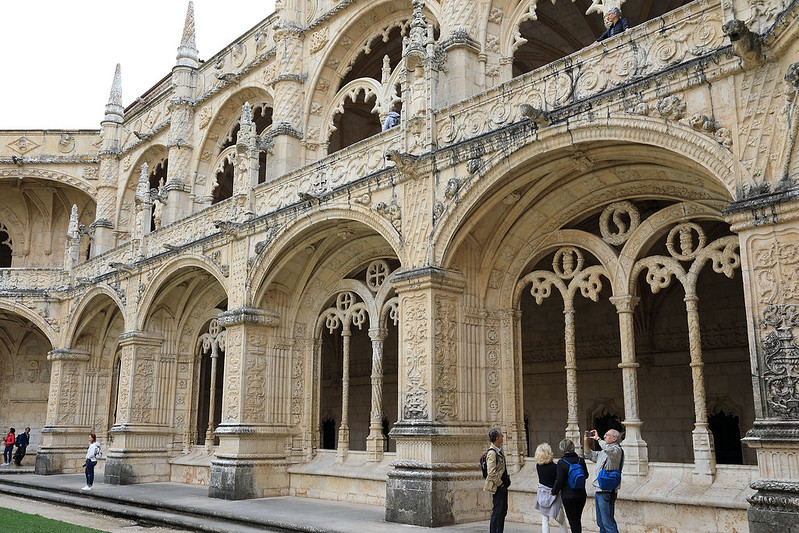 Cloister of Monastery dos Jerónimos |
A minute later the doors opened and they started letting people in. We entered after having our ticket scribbled on by a staff member, and found ourselves in the cloister. This was an amazing place, with intricate limestone decoration of the square courtyard with a double storey colonnade with cross cut corners. Several people were wandering around admiring it, but it wasn’t crowded and they seemed to be rationing the rate of entry to people from the queue behind us, so it never got really full.
 Colonnade in the cloister of Monastery dos Jerónimos |
We explored the levels in detail, ascending to circle the upper floor and inspect some of the open rooms leading off it, which contained displays of things. One room was the large refectory, where the monks used to dine, which was decorated with impressive painted wall tiles. Another room contained a very well put together display about the history of the monastery and this area of Portugal, with a comprehensive timeline that ran around the room, in Portuguese and English. The monastery was built from the 12th century and was an important part of the local area for centuries. One door on the upper floor led to the choir area of the attached church, from which we had a bird’s eye view of the people milling about on the ground floor via the free entry to the church.
 Upper floor of the cloister of Monastery dos Jerónimos |
Which was where we moved next after finishing all of the cloister area. The monastery seemed a lot bigger than the area that was open to the public, but the cloister area by itself was definitely worth the visit. The church area was okay but paled in comparison, and it was less pleasant to visit because it was packed with people, shuffling along the tour route slowly because there was no way to move any faster or slower due to the masses of people all around.
 Church of Monastery dos Jerónimos |
After leaving dos Jerónimos, we went out to the park across the road, where there were stalls set up. One area seemed to be a row of charity and political stalls, and there was a small stage where people in costumes were doing folk dances. Across the street in the other half of the park was a square of larger food and crafts stalls. There was also a group of people in traditional costumes, wandering around and playing music. There was a Punch and Judy style of puppet show, and another stage where a DJ was pumping out rhythms, but where perhaps later there’d be some live music.
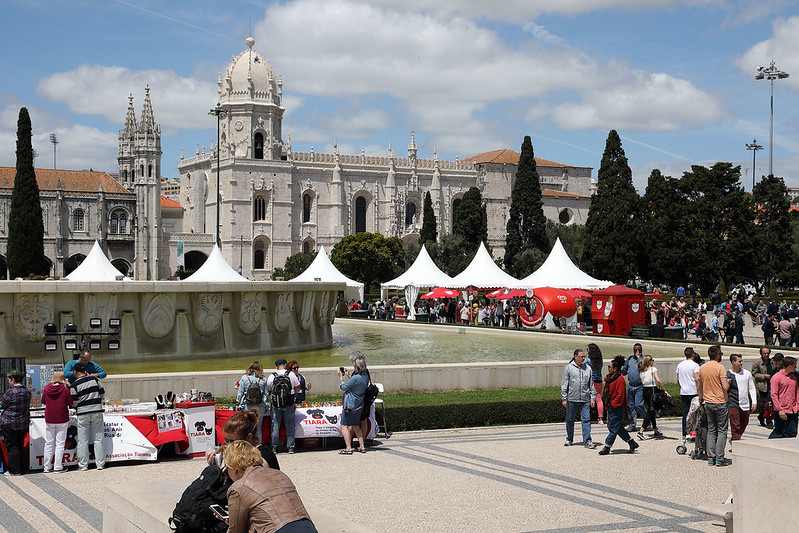 Market in front of the Monastery |
The food stalls were mostly places frying up chorizos and blood sausage, and offering various sandwiches with cured meats and cheese. It was all very carnivorous, but we found one stall that had just cheese on a sandwich, and also goat’s cheese and honey. M. chose one of the latter, while I picked one with prosciutto and cheese. We sat at a table next to the stall and ate. I went to get a bottle of water after finishing my sandwich, which was very salty. The same stall sold them for 1.50€, but it was busy so I went to another stall that was selling glasses of wine, and they only charged me 1€.
 Woman buying sausages at the market |
After eating, we walked further west to the Tower of Belém. We approached along a street running parallel to the river but a block inland, so the view of the Tower was blocked by buildings. When we turned the corner and saw the Tower, at first I was shocked by how small it was. I’d expected a vast castle structure, but it was only about the size of a three storey office building.
 Tower of Belém, from the adjacent park |
The medieval Tower sits in the river, in a small bay, surrounded by water. We approached across the grassy park in front of it, where many tourists were walking and gawking. Some people, presumably locals, had rabbits which they were letting run free on the grass, a bit like dogs. At the Tower, a small wooden bridge connected it to the land, and the bridge was full of people queued up to enter the Tower. There was a ticket kiosk further back. We briefly considered getting tickets, but the day was warming up and now very sunny, and the entire queue was exposed and barely seemed to be moving at all. So we satisfied ourselves with some photos of the exterior of the Tower.
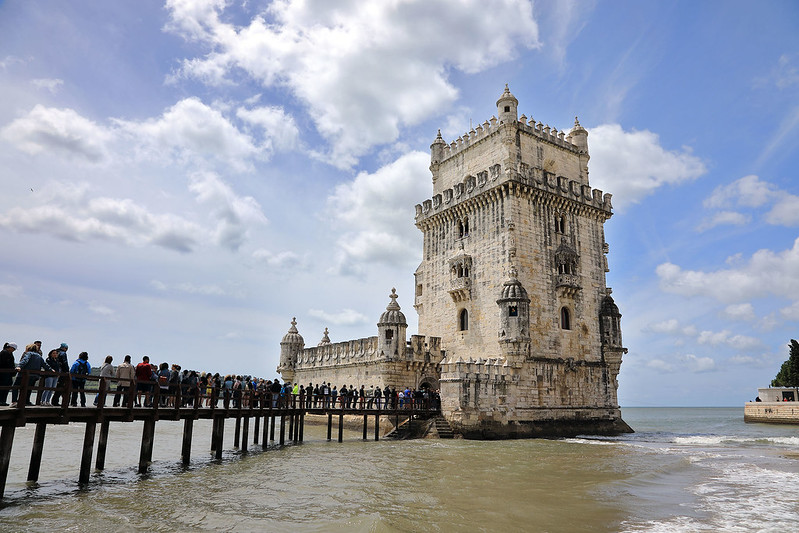 Tower of Belém, sitting in the river |
We walked back towards the monastery, stopping at a self-serve cafeteria style cafe to sit in the shade for a bit and have a drink. M. got a cappuccino while I had a Super Bock beer to refresh myself. The drinks came with bar coded tickets to use the toilets for free – non customers had to buy a ticket at a machine for 50 cents. I checked using the WiFi for something else to see at Belém before we returned to Lisbon and found the number three attraction after the monastery and tower was the National Palace of Ajuda. I located it on Google Maps, which said it was about a 40 minute walk.
So we set out, back past the monastery and the Pastéis de Belém shop, then turned left to go inland away from the river at the next street. This turned out to be uphill, gently at first, but then getting steeper as we continued. We passed several military looking buildings, including one which was a training facility for horses, with a large indoor arena with a sand floor that we could see through the windows. Fortunately most of the walk was in the shade as we slowed down and got warm in the afternoon sun.
Reaching the top of the hill, we took a loop road round the palace to the entrance. I was a bit worried that there didn’t appear to be any tourists whatsoever around, and hoped that the palace wasn’t closed for the day. But it was open, and we went into the ticket office area and paid 5€ each. The office was in one of the rooms of the palace, specifically the halberdier’s room, with displays of a few dozen guardsmen’s halberds in oak racks around the room.
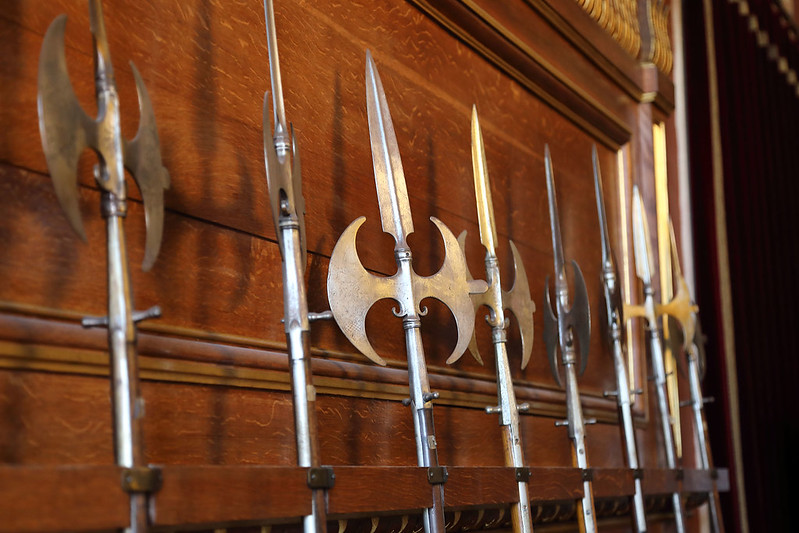 Halberdiers’ room, Palace of Ajuda |
This palace was the last royal palace in Portugal, in use up until 1910 when the monarchy was overthrown and the republic of Portugal proclaimed. And it’s still in use today for some official functions of the President. In particular, the impressive banquet hall, which we saw on the self-guided tour, is used for state banquets to this day.
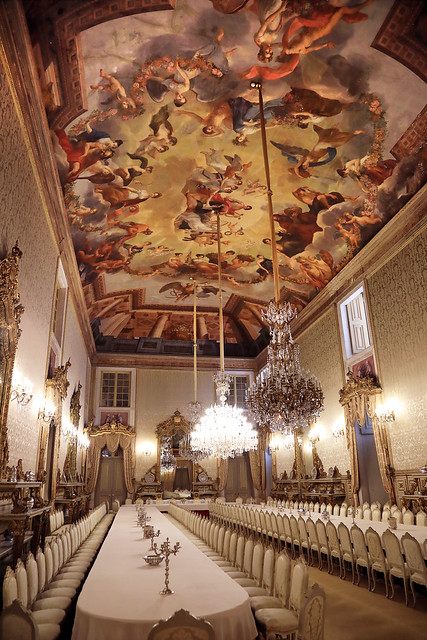 Banquet room, Palace of Ajuda |
Most of the rest of the rooms though were preserved in a state similar to their use in the late 19th century. We passed through various rooms where officials and dignitaries either waited or met with the king, as well as private living rooms of the king and queen, and less formal rooms where they entertained guests or friends. There was a music room, and a smoking room, and a billiards room, and then some rooms decorated in a Moorish style and a Chinese room. We also saw the throne room, where matching thrones for the king and queen stood on a dais in this grand chamber with a vast ceiling.
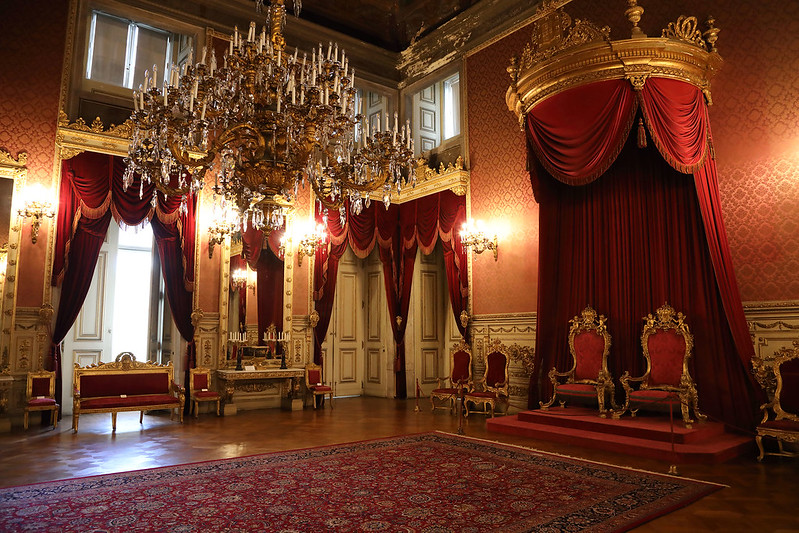 Throne room, Palace of Ajuda |
Overall it was an impressive collection of rooms and furnishings, and I’m glad we walked up the hill to see it. There were a few other people going through the rooms in front of and behind us, occasionally overtaking along the tour route, but mostly we had each room to ourselves or with just a couple of other people looking around.
We left and walked back down the hill. Behind us were a young couple who we could overhear talking with Australian accents. By now it was close to 17:00. We went back to the station to wait for a train back to Cais do Sodré. We decided that we would go from there to check out the Mercado di Ribeira, also known as the Time Out Market after its commercial sponsor, which M. had visited but I had not seen yet. It is just across the street from Cais do Sodré station. It has a fresh food market section, which operates from 06:00 to 14:00, so that was closed now. But the main part of the market is a large undercover area which is effectively a giant food court, with stalls around the outside and lots of bench seating in the middle, plus a few island stalls among the seats.
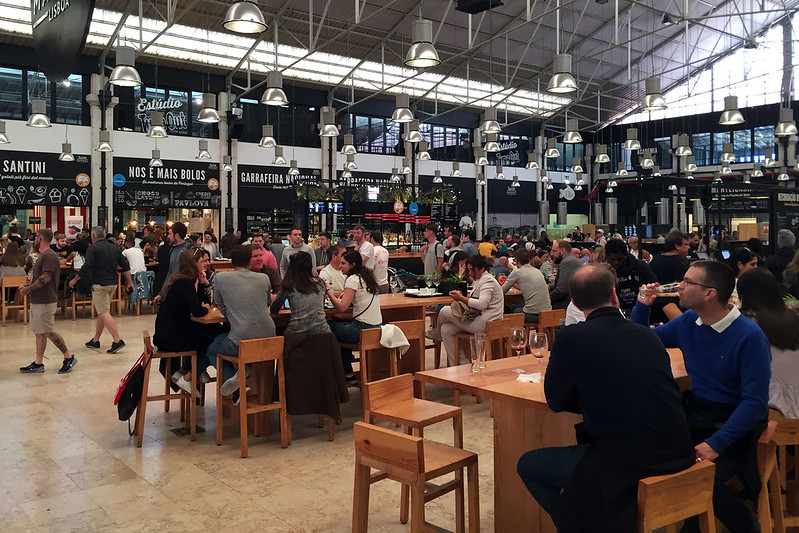 Time Out Market |
We walked around the perimeter, looking at all the available food and drink. It all looked to be pretty good quality, nothing trashy or junky. We decided to sit at one of the bars and have a drink until 18:00 and then go in search of a good restaurant to have dinner nearby. M. had a mojito on my suggestion when she said she wanted something refreshing and with soda water in it, while I had an Aperol spritz. We sat and enjoyed our drinks while watching the buzz of people having meals in the market.
 Drinks at Time Out Market |
For dinner, we wanted to check Cantinho do Avillez, a restaurant we’d passed the other night after eating at Cafe No Chiado, just a few doors up the street. But when we reached it, we saw that it didn’t open until 19:00, which was too long for us to wait. So we went a few doors further down to Xapuri, which advertised itself as a bistro. It looked good and had some good sounding vegetarian dishes, so we went into the dim interior with square columns supporting a vaulted ceiling and too, a table by the front window, where we could see the number 28 tram rattling by up the hill towards the main square of Chiado. The place was empty of diners, which we thought increasingly odd as only two other tables came in while we were dining. It was close to areas where tourists flock, so I was surprised that more didn’t find their way here.
 Polenta ronds with cheese and pesto, Xapuri Bistro |
It certainly wasn’t the food putting them off, because what we had was delightful. We shared tapas plates of: a tartare of eggplant with feta foam, cherry tomatoes, rocket, and croutons; polenta rounds stuffed with four types of cheese and topped with pesto; falafels with a yoghurt sauce, which had dill in it and I think some sour cream; and for me grilled octopus with spicy couscous and popadoms.
 Grilled octopus with couscous, Xapuri Bistro |
And then for dessert I had “variations on the theme of chocolate”, which was a warm chocolate brownie, white and dark chocolate mousse, white chocolate ice cream, with a thin dark chocolate snap, chocolate soil crumbs, and spots of a raspberry sauce and another sauce, which was pale yellow and sort of like a sweetened ricotta or mascarpone. It was all very good, except that the falafels could have had a bit more seasoning to them.
 Variations on the theme of chocolate, Xapuri Bistro |
After dinner we walked back past Cantinho do Avillez, where I popped in and made a reservation for Wednesday next week, our final night in Lisbon after returning from Porto. I think making a booking was a good idea, as they had queues of people waiting for tables. We walked the short distance to Baixa-Chiado station and caught the metro back to our hotel, to turn in for our final night at Entrecampos.

I’d heard of the Brazilian city of Belem, so naturally it must be named after the Portuguese one, right? It turns out that’s the Portuguese word for Bethlehem! [The More You Probably Already Know]